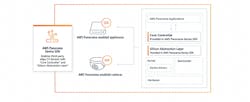Last week, Amazon AWS introduced a new piece of video technology at its multi-week AWS re:Invent event called AWS Panorama, which the company has labeled as a CV (computer vision) product. In fact, it is a machine learning appliance that is designed to add analytics capabilities to any camera that does not have them, which of course includes analog cameras connected via IP encoders (such as those provided by Axis Communications).
AWS refers to its analytics as “CV applications” which, while being a technically accurate label, also positions their applications as something different from existing security video analytics – which they are. The Panorama technology includes connectivity components that are not part of typical video analytics offerings; furthermore, AWS offers the Panorama Device SDK (software development kit) as part of the Panorama technology.
One purpose for the SDK is to enable device manufacturers to embed the technology in IP cameras, analog encoders and recording devices to help them increase the value of their products. AWS announced Axis Communications and VIVOTEK as two such partners.
Another SDK purpose is to enable third-party developers to produce Panorama CV applications, with AWS providing the deployment infrastructure so that the application developers only need to be concerned with the specific analytics use cases they are addressing. That could be a significant improvement to the security industry video analytics landscape if the Panorama technology achieves the broad success that AWS intends for it.
Basic Purpose
The basic purpose of the Panorama technology is to enable video analytic processing of camera video streams close to the cameras (or in them) while also providing built-in connectivity to AWS-based cloud analytics platforms.
The technology optimizes the physical location of the analytic computing elements, which has presented a significant networking challenge for video security deployments since IP cameras first arrived. The further video data must be transmitted – especially to the cloud – the greater the networking challenge and potential cost.
The Technology Context for Panorama
IT convergence is what has catapulted security industry technology into its current position as high-value technology, as has happened with the technology of many industries. That convergence continues because new technology capabilities keep expanding and increasing the value of using technology – and that value is what our clients and customers need and want.
As we already know, IT means information technology, and the information aspect of today’s technology is what is growing by leaps and bounds. Today’s devices and systems take in much more information than ever before, and so they have to process and transmit (exchange) much more data than ever before. Their value is magnified by how many ways they can participate in the information exchanges of various system infrastructures with which they can interact.
Thus, security technology service providers are becoming true system integrators (as opposed to just being installers), because the value of the products and systems they offer derives from their information-based integration capabilities.
Panorama technology offers well-documented integration capabilities through its Panorama API (application programming interface), providing a well-documented and stable interface capability for systems integrators to use.
Convergint Technologies and Stanley Security are two such integrators who are AWS partners and were mentioned in the AWS Panorama announcement.
Three Technology Differences
There are three critical ways that today’s security technology differs from that of previous decades. First, today’s products and systems are highly programmable. Their functionality is software-based, and that functionality evolves in place through software and firmware updates. That requires connectivity.
Second, today’s devices and systems handle volumes of data at scales unimaginable just a few years earlier – and that will always be the situation due to exponential technology advancement.
Third, products and systems are no longer standalone products and systems; instead they are part of infrastructure at two levels: computing and networking physical hardware technology infrastructure (site physical infrastructure), and information systems digital data infrastructure (including building management and business operations information stakeholders).This information infrastructure is the domain of an organization’s data governance function, something I’ve been writing a lot about recently because it’s the domain that identifies, protects and maximizes information value – and we in the security industry haven’t been giving it the attention our clients and customers deserve.
The Panorama technology accounts for and takes maximum advantage of all three factors. In doing so, it provides a boost for upgrading the full spectrum of existing video systems, because DVR, NVR and video server hardware does not need to be replaced to incorporate analytics into the video system.
Again, it is not just one brand of analytics, but a capability for seamlessly running Panorama CV applications from multiple vendors in cameras, on-premise appliances, and in the cloud.
Panorama provides an Edge and Cloud CV application infrastructure with a technology that has built-in cloud platform connectivity and is open to third-party CV application developers and edge device manufacturers. That is definitely a significant positive change in the landscape of physical security industry technology, which overall has a history of being highly proprietary and not very open.
This is just one part of the broad AWS vision from the company that is leading the Gartner Magic Quadrant for Cloud Infrastructure and Platform Services. We should learn more as AWS re:Invent continues through Dec. 18.
About the Author:
Ray Bernard, PSP CHS-III, is the principal consultant for Ray Bernard Consulting Services (RBCS), a firm that provides security consulting services for public and private facilities (www.go-rbcs.com). In 2018 IFSEC Global listed Ray as #12 in the world’s Top 30 Security Thought Leaders. He is the author of the Elsevier book Security Technology Convergence Insights available on Amazon. Mr. Bernard is a Subject Matter Expert Faculty of the Security Executive Council (SEC) and an active member of the ASIS International member councils for Physical Security and IT Security. Follow Ray on Twitter: @RayBernardRBCS.



